

IN-CAMPUS OFFICE

INTERDISCIPLINARY TEAM & SPACE FOR AVOIDING
STUDENT DROP-OUTS
I
N D E X Definition
Functions 2. Expert profiles and roles 3. Arrangement of the in-campus office 4. Effective collaboration 5. Intervention and workflow
6. Meetings of the in-campus office
7. Annexes / Summary of templates
8.
The in-campus office is a dedicated physical space designed to provide comprehensive support for students at risk of dropping out of courses within the Vocational Education and Training (VET) environment.
This full operating office brings together interdisciplinary teams to effectively address the multifaceted challenges faced by these students. The office encompasses four specific functions that collectively aim to enhance student retention and success.
In summary, the in-campus office plays a vital role in supporting students in the VET environment by addressing the diverse and complex challenges that may lead to course dropout. Through its multidisciplinary approach, the office strives to foster student resilience and success.

FUNCTION 1 GENERAL INFORMATION
The office serves the first contact point for students, offering essential information regarding academic programs, resources, and institutional policies. By providing clear and accessible guidance, the office ensures that students are well-informed and equipped to navigate their educational pathways.
FUNCTION 2 PEDAGOGICAL SUPPORT
Understanding that academic challenges often intersect with mental health issues, this function focuses on offering pedagogical strategies and psychological resources. Trained staff are available to provide personalized counselling, tutoring, and mentorship, fostering an environment conducive to learning and personal growth.
fUNCTION 3
socio-economic support
Socio-economic factors significantly impact student success, therefore one of the functions is to provide support related to financial aid, scholarships, and job placement opportunities. By connecting students with available resources, the office aims to mitigate economic barriers that may hinder their educational progress.
FUNCTION 4
ADMINISTRATIVE SUPPORT
Lastly, the administrative support aims at facilitating the process of dealing with bureaucratic challenges. Whether it involves course registration, appeals, or other administrative matters, staff are available to assist students in navigating these processes efficiently.
The interdisciplinary team within the in-campus office is structured to encompass a diverse range of professional expertise, ensuring a holistic approach to avoid student support.
The composition of this team is vital for addressing the various challenges that students may face, particularly those at risk of dropping out of their courses.
Each of the four designated professional sectors brings unique skills and knowledge that contribute to the overall effectiveness of the office and each group is connected to the aforementioned functions:
GROUP 1
EDUCATORS, TEACHERS, TUTORS
This group provides essential academic support and guidance, fulfilling the first function of the office, which focuses on general information.
Members of this group are responsible for helping students navigate their educational programs, understanding course requirements, and accessing appropriate learning resources.
GROUP 2 PEDAGOGISTS, PSYCHOLOGISTS
Representatives from this sector are crucial for the second function, which emphasizes pedagogical and psychological support. Their background in pedagogy or psychology enables them to address the emotional and mental health needs of students.
They can provide counseling for those experiencing stress, anxiety, or other issues that may affect their academic performance.
GROUP 3
SOCIAL EDUCATION WORKERS
This group plays a significant role in the third function, which focuses on socio-economic support and opportunities. Social education workers and social workers bring expertise in identifying and addressing socio-economic barriers that students may encounter.
They can connect students with financial resources, social services, and community programs, ensuring that all students have equitable access to support systems that facilitate their educational journey.
As it is not common that educational centers count with in-house social workers, this is a function that could be externalized by creating a support network of social workers that can participate in an intervention when needed.
0 3
GROUP 4
SCHOOL ADMINISTRATIVE STAFF
The final group encompasses professionals dedicated to administrative support and consultation, fulfilling the fourth function of the office.
With backgrounds in human resources and administration, these individuals are well-equipped to assist students with administrative processes, such as course registration, academic and bureaucratic issues.
In summary, the interdisciplinary team of the in-campus office should consist of at least one representative from each of the four professional groups.
This collaborative approach ensures that students receive individualized support throughout their educational experiences, effectively addressing the multifaceted challenges that contribute to course dropout.
4
ARRANGEMENT OF IN-CAMPUS OFFICE

Objective:
To create a physical and virtual space that fosters collaboration among experts from four distinct groups, thereby enhancing interdisciplinary engagement and innovation.
The in-campus office is a space and a team that strive towards a common objective: avoiding students drop-outs.
Characteristics of the In-Campus Office:
The In-Campus Office should be understood as a project → a unique effort that brings concrete results in a specific period.
To ensure that the in-campus office can be adapted to different settings, it is understood as a collaborative effort that can take place both, online and offline.
ARRANGEMENT OF IN-CAMPUS OFFICE
Location: The office should be situated in a central area on campus to ensure easy accessibility for all team members.
Physical Space
Design: The space should feature open-plan layouts to facilitate interaction, alongside designated private areas for focused work. It may also include flexible meeting rooms equipped with state-of-the-art audio-visual technology to accommodate different group sizes.
Amenities: Adequate resources such as high-speed internet, whiteboards, teleconferencing equipment, and comfortable seating arrangements should be provided to encourage collaboration and brainstorming.
Online Space
Online platforms and tools should be used to complement the physical office, enabling remote participants to engage effectively (Zoom, teams, SharePoint etc.).
This platform should allow for video conferencing, document sharing and collaborative tools (e.g., virtual whiteboards).
Online forums and communication channels (such as Slack or Teams) can be established to ensure continuous interaction among team members, regardless of their physical location.
TIPS & TRICKS
Establish Clear Goals: Initiate projects by collectively defining clear, achievable goals that resonate with all disciplines involved.
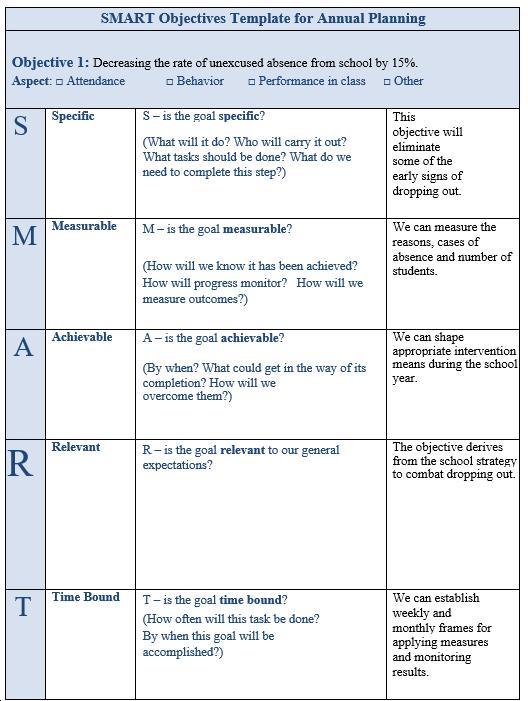
TIPS & TRICKS
Foster Open Communication:
Create an environment where all members feel comfortable sharing ideas and feedback. Regular check-ins can help maintain alignment and address any concerns early on.

Encourage Mutual Respect: Acknowledge and appreciate each member's expertise. It is essential to foster respect among disciplines to enhance collaboration.
Utilize Diverse Skill Sets:
Encourage team members to leverage their unique skills and perspectives for innovative problem-solving. This may involve forming sub-groups based on specific project needs.
Establish common knowledge about dropouts: If an interdisciplinary team has the same vision about drop-outs, it will be easier to cooperate. In that sense, it is important to foster learning about the topic. You can use the TeSTED Moodle to
TIPS & TRICKS
Facilitate Team-Building Activities:
Organize workshops or social events that promote team bonding. These activities can enhance relationships and trust among team members, ultimately improving collaborative efforts.
Implement Feedback Mechanisms:
Regularly solicit feedback on the collaborative process and be willing to adapt practices to optimize effectiveness.
RECOMMENDED TOOLS:
Meeting scheduling - DOODLE
Task management - Trello
Community engagement - Slack
Interactive presentations - Mentimeter

Interactive materials for studentsMagicSchool
5
INTERVENTION STRATEGY
The intervention strategy relies on a lot in interdisciplinary work, which starts with the teacher as an observer of behavior and a responsible for constant monitoring of student performance.
For this purpose, the Tested Project offers has created an intervention strategy consisting of 5 main steps, which can be adapted to the context of each school and education center.
S T E P 1
Monitoring & behavior tracking
WHO: Group 1 (Teachers and educators)
The Self-Assessment Tool, which can be used regularly to detect if some student is at risk of dropping out:
TeSTED Self-assessment Tool

5
S
T E P 2
Information sharing with In-campus Office
WHO: Group 1 and 2 (Teachers, educators, pedagogists, ect)
In regular meetings of the in-campus office, the cases of students at risk will be highlighted.
Discussions should be held at least once a month so the office can plan strategies to avoid drop-outs.
Strategies can include actions to raise awareness on the topic and to discuss the potential drop-outs priority cases. If there are any students facing a delicate situation, an individualized case meeting will be arranged.

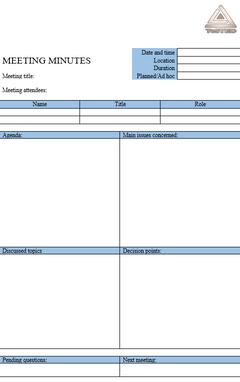



S T E P 3
Intervention through case handling mechanism
WHO: Group 1, 2, 3 and 4 (Teachers/educators, pedagogists, administrative staff and social workers)
The whole in-campus office will be responsible for preparing a personalized strategy for the student at risk.
This process is supported by the Case handling mechanism, which provides teachers with a set of tools like reporting templates, flowcharts and information on potential support networks.
Templates can be used to ensure all aspects of the student’s situation are reviewed, such as academic performance, emotional well-being, and social integration.
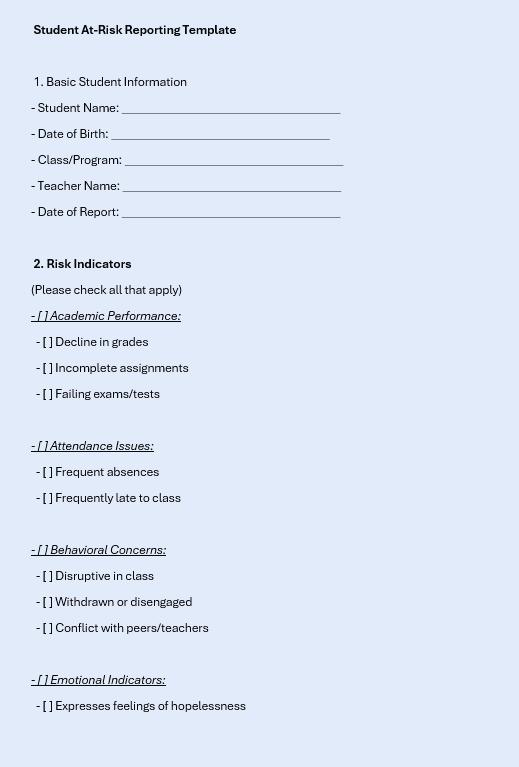

S T E P 4
Archiving cases
WHO: Group 1, 2 (Teachers/educators and pedagogists)
Closing Meetings aim to gather final feedback and evaluate the overall impact of the intervention. This includes documenting lessons learned and best practices, which can inform future cases.
Using the Cases Library Template, the team can record cases stories in an anonymized way to build a foundation for knowledge-sharing within the team and with partner organizations.
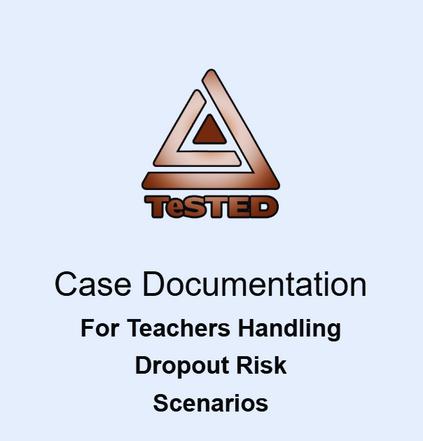
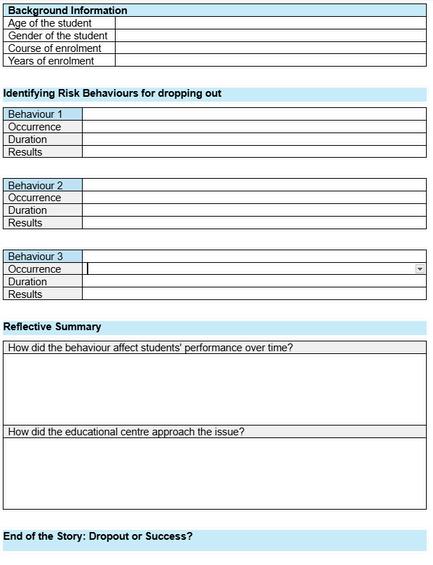
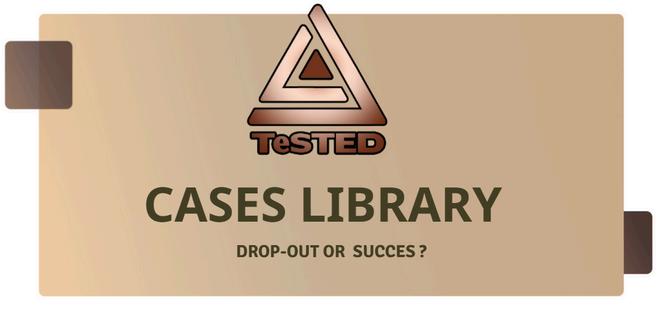
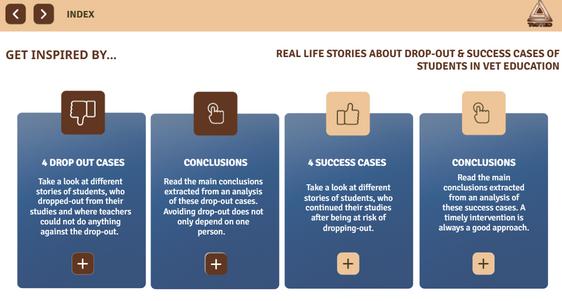
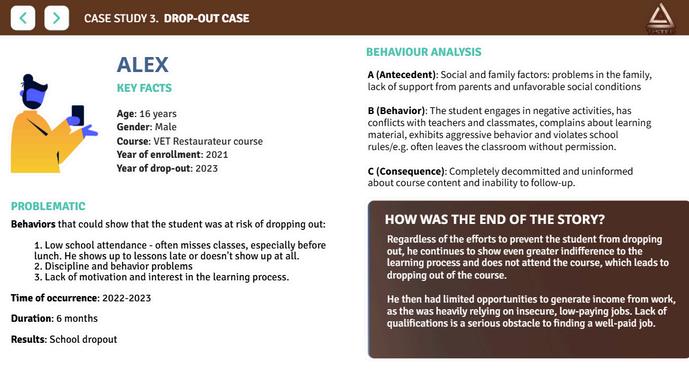
TEMPLATES & TOOLS
SMART Objectives Template
Meeting Minutes Template
Events calendar Template
Self-assessment Tool
Psychometric test Template
Case Handling mechanism
Info-package about Drop-outs for students
Cases Library Template
Cases Library

PROJECT & PARTNERS
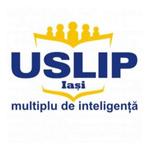
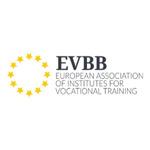



USLIP - Romania
EVBB (Germany/Brussels)
BK-Consulting (Germany)
ipcenter.at (Austria)
DAYANA (Bulgaria)


